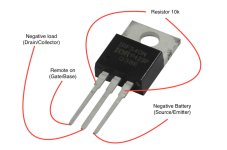davideserin
1 W
- Joined
- Feb 1, 2016
- Messages
- 63
Hi,
I just tried to make a mosfet switch to turn on my DCDC for the bike lights. I wored it so that when the controller is turned on and 5v is present, it would open the gate for the full volts to the DCDC. I want to do this as my battery is 77v and the switches and relays are only up to about 28v DC.
I tried this and must have got the circuit wrong as I fried my Phaserunner. The Phaserunner and the Mosfet switch shared a ground, but the only other cable was the 5v throttle supply that i used for controlling the gate.
I've successfully used the IRF540n on a different controller:
https://docs.rs-online.com/54b2/0900766b801f1b4d.pdf
But had the issue when using the IRF1620G withe the Phaserunner:
https://docs.rs-online.com/54b2/0900766b801f1b4d.pdf
This is my wiring:

I am going to buy another Phaserunner and i'd love to use this solution, but obviously i need to be 100% confident this won't fry it again!
Are there any other solutions for controlling high voltage DC with 5v? I need it to be small as it need to fit in the rear cavity of a cafe racer LED headlight. I also want it to be completely isolated from the high voltage Drain.
Thanks!
I just tried to make a mosfet switch to turn on my DCDC for the bike lights. I wored it so that when the controller is turned on and 5v is present, it would open the gate for the full volts to the DCDC. I want to do this as my battery is 77v and the switches and relays are only up to about 28v DC.
I tried this and must have got the circuit wrong as I fried my Phaserunner. The Phaserunner and the Mosfet switch shared a ground, but the only other cable was the 5v throttle supply that i used for controlling the gate.
I've successfully used the IRF540n on a different controller:
https://docs.rs-online.com/54b2/0900766b801f1b4d.pdf
But had the issue when using the IRF1620G withe the Phaserunner:
https://docs.rs-online.com/54b2/0900766b801f1b4d.pdf
This is my wiring:

I am going to buy another Phaserunner and i'd love to use this solution, but obviously i need to be 100% confident this won't fry it again!
Are there any other solutions for controlling high voltage DC with 5v? I need it to be small as it need to fit in the rear cavity of a cafe racer LED headlight. I also want it to be completely isolated from the high voltage Drain.
Thanks!

